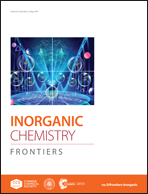Graphene/graphene nanoribbon aerogels decorated with S-doped MoSe2 nanosheets as an efficient electrocatalyst for hydrogen evolution†
Abstract
Searching for an efficient and cost effective electrochemical catalyst is regarded as the key challenge for the hydrogen evolution reaction (HER). Both the active sites and electrical conductivity of the catalysts should be carefully engineered to improve their HER performance. In this work, S-doped MoSe2-decorated graphene/graphene nanoribbon aerogel (S-MoSe2@GGNR) hybrids have been fabricated as high-performance electrocatalysts for HER. The unique nanoribbon-interconnected-nanosheet structure of the graphene/graphene nanoribbon aerogel (GGNR) provides an open structure for fast ion diffusion and conductive channels for fast electron transport. GGNR as a substrate could prevent MoSe2 nanosheets from agglomeration and fully expose the active sites of MoSe2, while further S-doping can modify its electronic and crystalline structure, which can improve the activity of the catalytic sites. Consequently, the S-MoSe2@GGNR hybrids exhibit outstanding electrochemical activity with a potential of −153 mV vs. reversible hydrogen electrode to achieve a current density of 10.0 mA cm−2 and a small Tafel slope of 46 mV per decade. The good performance of the S-MoSe2@GGNR hybrids can be credited to synergistic effects between the unique hierarchical architecture of carbon aerogels and positive effect of S-doping, which makes them promising electrocatalysts for hydrogen production.



 Please wait while we load your content...
Please wait while we load your content...